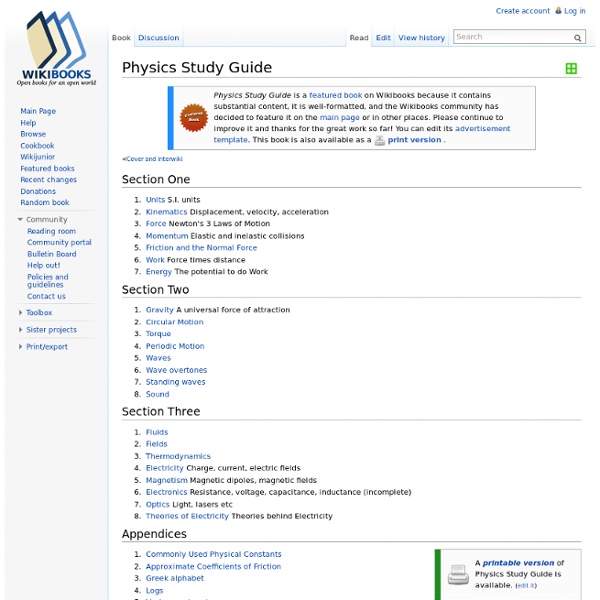Physics Study Guide - Wikibooks, collection of open-content textbooks
Xania has nominated himself for use of the Checkuser tools. Please provide your input on this important decision. From Wikibooks, open books for an open world <Cover and interwiki Introduction Section One Units S.I. unitsKinematics Displacement, velocity, accelerationForce Newton's 3 Laws of MotionMomentum Elastic and inelastic collisionsFriction and the Normal ForceWork Force times distanceEnergy The potential to do Work Section Two Section Three FluidsFieldsThermodynamicsElectricity Charge, current, electric fieldsMagnetism Magnetic dipoles, magnetic fieldsElectronics Resistance, voltage, capacitance, inductance (incomplete)Optics Light, lasers etcTheories of Electricity Theories behind Electricity Appendices
Cocktail Party Physics
The Physics Classroom
The Science Spot
DOLORES GENDE: PHYSICS TUTORIALS
- College Prep Physics: - Honors Physics: - AP Physics B: Select the Physics topic you want to review from the pulldown menu below:
FQXi
FQXb (bio)By WILLIAM OREM • Mar. 23, 2014 @ 21:39 GMT Everyone is talking this week about the dramatic confirmation of inflationary theory: those first-instant gravitational waves whose details may even point--being, if you will, quantum phenomena that went suddenly ultra-macroscopic--toward the correct way to unify QM and GR. I myself have been musing on rather astonishing work in another field. Recently the big news there was released: an unprepossessing experiment involving a weak acid bath showed it's possible to revert mature, differentiated cells to a stem cell state, allowing for the prospect of wholesale repurposing. This is the angle most science journalists gave the discovery last month: "Outsider runs outrageous experiment, stumbles upon success." Alas--you knew this part was coming--it is now looking like the champagne may have been premature. Either way, though, I'm left musing. As a finding, it's counterintuitive. Is this a natural propensity of all cellular life? 1. 2. 3.
Free Physics Textbook
HyperPhysics Concepts
About HyperPhysics Rationale for Development HyperPhysics is an exploration environment for concepts in physics which employs concept maps and other linking strategies to facilitate smooth navigation. For the most part, it is laid out in small segments or "cards", true to its original development in HyperCard. The entire environment is interconnected with thousands of links, reminiscent of a neural network. Part of the intent for this exploration environment is to provide many opportunities for numerical exploration in the form of active formuli and standard problems implemented in Javascript. New content for HyperPhysics will be posted as it is developed. A resource that was initiated as a resource for local high school physics teachers whom I had taught has expanded into an intensively used website worldwide. CD or DVD versions have been sent to 86 countries to date, and translations into German, Italian, Chinese, and Español have been licensed and are underway. HyperPhysics (©C.R.
Interactions.org
Math, Physics, and Engineering Applets
Oscillations and Waves Acoustics Signal Processing Electricity and Magnetism: Statics Electrodynamics Quantum Mechanics Linear Algebra Vector Calculus Thermodynamics Mechanics Miscellaneous Licensing info. Links to other educational sites with math/physics-related information or java applets useful for teaching: And when you get tired of learning, here is some fun stuff: Pong Simulation Circuit-level simulation of original 1972 Pong.
Not Even Wrong
I’ve just replaced the old version of my draft “spacetime is right-handed” paper (discussed here) with a new, hopefully improved version. If it is improved, thanks are due to a couple people who sent helpful comments on the older version, sometimes making clear that I wasn’t getting across at all the main idea. To further clarify what I’m claiming, here I’ll try and write out an informal explanation of what I see as the relevant fundamental issues about four-dimensional geometry, which appear even for $\mathbf R^4$, before one starts thinking about manifolds. Spinors, twistors and complex spacetime In complex spacetime $\mathbf C^4$ the story of spinors and twistors is quite simple and straightforward. While spinors are the irreducible objects for understanding complex four-dimensional rotations, twistors are the irreducible objects for understanding complex four-dimensional conformal transformations. Real forms In this case the conjugation acts in a subtle manner. Some philosophy
Related:
Related:



